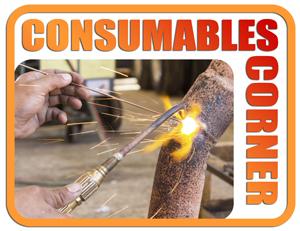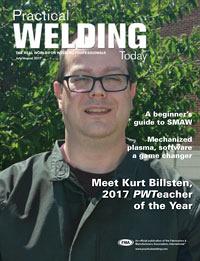Independent welding consumables professional
- FMA
- The Fabricator
- FABTECH
- Canadian Metalworking
Categories
- Additive Manufacturing
- Aluminum Welding
- Arc Welding
- Assembly and Joining
- Automation and Robotics
- Bending and Forming
- Consumables
- Cutting and Weld Prep
- Electric Vehicles
- En Español
- Finishing
- Hydroforming
- Laser Cutting
- Laser Welding
- Machining
- Manufacturing Software
- Materials Handling
- Metals/Materials
- Oxyfuel Cutting
- Plasma Cutting
- Power Tools
- Punching and Other Holemaking
- Roll Forming
- Safety
- Sawing
- Shearing
- Shop Management
- Testing and Measuring
- Tube and Pipe Fabrication
- Tube and Pipe Production
- Waterjet Cutting
Industry Directory
Webcasts
Podcasts
FAB 40
Advertise
Subscribe
Account Login
Search
Consumables Corner: How shielding gases affect the welding arc, weld bead
- By Nino Mascalco, Rob Koltz, and Steve Sigler
- August 1, 2017
- Article
- Consumables
Q: In our shop we use gas metal arc welding (GMAW) and flux-cored arc welding (FCAW). We use a 90 percent argon/10 percent carbon dioxide (CO2) blend for GMAW and either a 100 percent carbon dioxide or 75 percent argon/25 percent carbon dioxide blend for FCAW. Every once in a while the FCAW gases will get used for the GMAW process, or the 90/10 will get used for the FCAW process. Is this OK or do we need to remove those welds and reweld the joints?
A: The answer isn't a simple yes or no. First, let’s look at how these shielding gases affect the welding arc and weld properties. Since you are using argon and CO2, we’ll focus on those.
The most common shielding gas for both processes is CO2 because its cleaning action and low cost. CO2 is an active gas, which means it reacts with other elements in the welding arc and molten weld puddle. In the intense heat of the welding arc, the CO2 breaks down into mainly carbon monoxide and oxygen. The free oxygen reacts with other elements and impurities in the weld joint or base material and is deposited on the surface of the solidified weld as an oxide or slag layer.
Some of the carbon monoxide recombines with oxygen or other elements and gives off heat or energy in the base material. This is one of the reasons CO2 has a broad and deep penetration profile. Additionally, CO2 has a high thermal conductivity which requires more arc voltage to maintain a stable arc, which aides in penetration.
CO2 produces a sound weld with good mechanical properties. The downside is it doesn't produce the most stable arc and typically generates a fair amount of weld spatter. Additionally, CO2 is not capable of producing the spray-transfer mode in the GMAW process. Only short-circuiting transfer (SCT) and globular transfer modes can be attained.
Argon is an inert gas that does not react with anything. It is more expensive upfront compared to CO2, but that doesn't necessarily mean it's more expensive to use. Its many benefits make it a desirable shielding gas for many applications. Argon can be used by itself to weld any ferrous or nonferrous base material. Small additions of other shielding gases are added to it to produce certain desired welding effects, such as helium for higher travel speeds or CO2 for cleaning action in the weld.
Another common addition is oxygen, typically in the 2 to 5 percent range, which improves arc stability, provides cleaning action, and improves the wetting action and bead shape of the weld. Oxygen is a stronger oxidizer than CO2, so a lower concentration is needed; however, it may require a filler metal with higher levels of deoxidizers to scavenge up the free oxygen to prevent porosity if the oxygen concentration goes above 5 percent.
Furthermore, argon is required at a minimum concentration of 80 percent to attain spray transfer in GMAW. Spray transfer produces a sound and nearly spatter-free weld with moderate to high travel speeds and with good bead appearance. Argon has lower ionization potential than the other shielding gases, which gives it the ability to produce a narrow, high-current-density arc that results in a deep and pointed penetration profile.
Since argon is an inert gas, there is more alloy recovery in the weld, which improves the mechanical properties. If superior impact strength is required, then argon blend shielding gases should be in the 80 to 95 percent range.
The 75 percent argon/25 percent CO2 blend is common for welding a variety of carbon steel applications, especially sheet metal where SCT is used in GMAW. Mixing argon with CO2 in the 5 to 25 percent range is fairly common and provides a broad range of applications with all around desirable effects.
To answer your question, the shielding gas used should not greatly affect the outcome if anything was welded with GMAW with respect to mechanical properties. However, if impact strength is an important variable, then you should use the shielding gas blend with the higher argon content. If you didn't, you wouldn't necessarily have to remove and reweld the joint because carbon steel solid-wire filler metals are not classified per AWS with specific shielding gases.
Alternatively, flux-core wires are AWS-classified with specific shielding gases due to the interaction of the flux and shielding gas. Using the wrong shielding may have detrimental effects on weld integrity. Most flux-core wires are classified with either 100 percent CO2 or a 75 percent argon/25 percent CO2 blend. Some are even dual classified with both of these specific shielding gases. There are even a few flux-core wires on the market that are classified with argon mixtures up to 90 percent, which would have been specially formulated by the wire manufacturer.
Depending on the application of the product being produced, if it was welded with an incorrect shielding gas for the filler metal type, removing and rewelding may be necessary. However, this decision may be at the engineer's discretion and depends on the welding code you are working to.
Conversely, if this happened on a large job that would have made it very costly to rework, performing a procedure qualification record (PQR) with the parameters and shielding gas used would have proven whether the integrity was compromised and if it is allowed.
About the Authors


Rob Koltz
Application Engineer
411 S. Ebenezer Rd.
Florence, 29501
636-485-2253
Steve Sigler
Application Engineer
411 S. Ebenezer Rd.
Florence, South Carolina 29501
636-485-2253
About the Publication
Related Companies
subscribe now

The Welder, formerly known as Practical Welding Today, is a showcase of the real people who make the products we use and work with every day. This magazine has served the welding community in North America well for more than 20 years.
start your free subscription- Stay connected from anywhere

Easily access valuable industry resources now with full access to the digital edition of The Fabricator.

Easily access valuable industry resources now with full access to the digital edition of The Welder.

Easily access valuable industry resources now with full access to the digital edition of The Tube and Pipe Journal.
- Podcasting
- Podcast:
- The Fabricator Podcast
- Published:
- 04/16/2024
- Running Time:
- 63:29
In this episode of The Fabricator Podcast, Caleb Chamberlain, co-founder and CEO of OSH Cut, discusses his company’s...
- Trending Articles
Sheffield Forgemasters makes global leap in welding technology

Welding student from Utah to represent the U.S. at WorldSkills 2024

Lincoln Electric announces executive appointments

Engine-driven welding machines include integrated air compressors

ESAB unveils Texas facility renovation

- Industry Events
16th Annual Safety Conference
- April 30 - May 1, 2024
- Elgin,
Pipe and Tube Conference
- May 21 - 22, 2024
- Omaha, NE
World-Class Roll Forming Workshop
- June 5 - 6, 2024
- Louisville, KY
Advanced Laser Application Workshop
- June 25 - 27, 2024
- Novi, MI



























